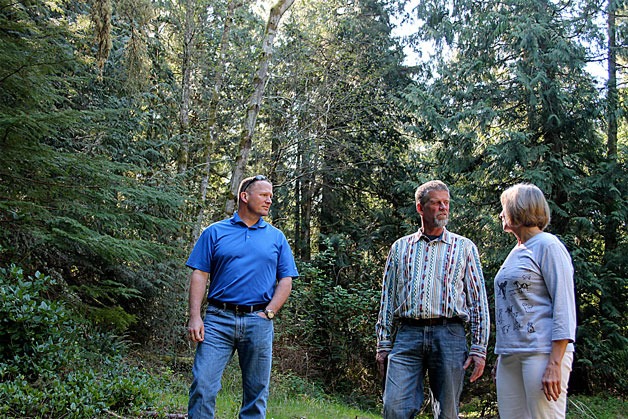Hoping to win favor and potentially future state funding, South Whidbey Parks and Recreation District officials gave two state lawmakers a tour of its new 30-acre campgrounds property last week.
On Friday, state Rep. Norma Smith, R-Clinton, and Rep. Dave Hayes, R-Camano, were given a rundown of the proposed campground designs by district leaders. Present were Commissioner Don Wood, Commissioner Mark Helpenstell and district Director Doug Coutts.
The district reached out to the 10th District lawmakers to educate them on the provisional plans and give updates on the planning process. Additionally, the commissioners are looking for funding from the Recreation and Conservation Office (RCO), which Smith and Hayes can advocate for.
Based on their initial impression, Smith and Hayes were impressed with the piece of land that is the proposed location for the campgrounds, particularly the natural beauty of the largely second-growth wooded area. The land being used is adjacent to Community Park and behind South Whidbey High School.
“There are some beautiful cedars here on this piece of land,” Smith said. “This is beautiful. I’m really glad I came to visit.”
They did, however, raise questions about keeping construction costs low. Cost-efficiency has been an important consideration throughout the initial planning process, though, and Coutts responded with plans for a single check-in building, restrooms, etc., though modular buildings are still being considered. Additionally, the design firm hired to create the campground layout, Seattle-based J.A. Brennan Associates, has prioritized integrating existing infrastructure into the plans in order to keep costs down. Existing logging roads are slated to be incorporated into the plan, as will the entrance at Community Park as opposed to building a new one.
“The modulars are a good option because they are cost-efficient,” Smith said.
At this stage of the planning process, there is little for Smith and Hayes to do on their end, as the meeting was more focused on getting an introduction to the land. The next stage in the process is for Parks & Recreation to select a preferred schematic design, as there are two options being considered: clustered camping or separated campgrounds that give campers more space. Upon selecting a preferred design, the district will then review the plans, decide whether or not to approve them, and then begin the process of seeking grants from the state Recreation and Conservation Office.
“This meeting was more about educating the representatives about what we are doing here with the campground plans,” Coutts said.
The desire to build more campgrounds came from a lack of camping options on South Whidbey, despite demand for camping being high, according to Helpenstell. The summer months on South Whidbey feature many festivals and sports matches, after which visitors want to camp.
The district purchased the land for $390,000 in October. The area is roughly 30-35 acres, according to Coutts, and is primarily wooded with second-growth evergreens. South Whidbey Parks and Recreation have presented the two concepts at two public meetings. There was an additional online survey for the public to vote on their preferred plan, but the South Whidbey Parks and Recreation district has yet to select a preferred design.
In the end, a major deciding point will be the amount of existing infrastructure utilized as well as keeping costs of construction low.
“The parks [board and staff] are really pushing for non-invasive construction,” Coutts said.
Smith spoke highly of the idea of non-invasive construction, as she said her first duty as a representative is stewardship — to maintain what the community has.
“Thank you for being the stewards of South Whidbey,” she said.



